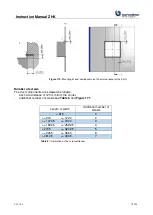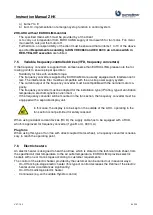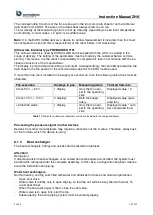
Instruction Manual ZHK
V07-19.0
87/129
The maximum allowed pressure difference of the plate heat exchanger is given in the plate heat
exchanger section
–
supply air in the technical data, see
. In the part of the technical data
of the exhaust air this value is not given, see
Possible causes for inadmissible pressure increase:
The following factors can cause pressure increasing and destroy the plate heat exchanger:
-
Dampers are closed or will be closed or open in delay.
-
Filters were not changed if they reached their final pressure drop.
-
The external pressure drop is higher than calculated.
-
Dampers in the duct system, unintended barriers, closed outlet grille or unfinished duct systems
can lead to additional external pressures.
-
Only one fan is working (supply- or exhaust air), which can increase the pressure in some cases.
7.7.2
Prevention measures
General measures:
It must be ensured on site, that all dampers, which have a pressure-in-
creasing effect. For example, outside air dampers, exhaust air dampers,
dampers in ducts, are not completely closed during commissioning and
operation!
Unless otherwise stated, the assumed pressure situation in the ducts (suction and pressure side) for
the technical design is based on the specification of EN13053. The real pressure situation in the
ducts must be checked before commissioning. If there are any deviations, EUROCLIMA must be
contacted.
In principle there are different technical measures, which contribute to the prevention of inadmissible
pressure in the plate exchanger. One of these measures is described in
chapter 7.7.3
7.7.3
Pressure monitoring with differential pressure switch
Additionally, to the general measures, pressure monitoring may protect the plate exchanger against
damage caused by steady pressure increase,
but not if the pressure increases abruptly.
Figure 185:
Plate exchanger section in technical data
–
supply air
–
maximum admissible differential pressure
Figure 186:
Plate exchanger section in technical data
–
exhaust air
Summary of Contents for ZHK Series
Page 1: ...ZHK INSTRUCTION MANUAL ...
















































